The Science Botany
Botany is the scientific study of plants.
The First Organisms
Close to 3.2 billion years ago, the earth’s surface and atmosphere became stable enough to support primitive life. Single cell organisms began to develop in the seas that covered the planet. Most of them were very simple single cellular bacteria that fed on chemicals in the ocean’s waters.
Since these simple beginnings it is estimated that around 8,000,000 different individual organisms share the planet with us.
When applied to all five known Eukaryote kingdoms of life on Earth, there is around 1,500,000 different plants specie on the planet of which less than half have been named. This refers to and includes plant sub specie and varieties.
There are around 611,000 species of fungi, moulds & mushrooms of which around 43,300 have been described and catalogued.
Our main interests lie in the plants monocotyledon and dicotyledon, fungi and Chromista. These plants range in size and complexity from the simple, tiny mosses to the giant soft wood Sequoia and hardwood Eucalyptus which are the largest living organisms on Earth. Their sizes range from the small unicellular (“Cella” is Latin for a small room as in a prison cell) plant like organisms the Protists, Fungi, minute mosses from 5mm to the forest hardwood giants of Australia and the soft wood giants of America which can grow to over 100 meters.
Scientists believe today’s plants probably all evolved from the blue-green algae and have been around since the early Palaeozoic era or more than 500 million years ago. The “green algae” is the most diverse group of algae, with more than 7000 species growing in a variety of habitats. The green algae belong to a paraphyletic group, because it excludes plants from the Plantae kingdom. Like plants though they are green, contain two forms of chlorophyll, which they use to capture light energy to fuel the manufacture of sugars, but unlike plants they are primarily aquatic. A paraphyletic group consists of all the descendants of the most recent common ancestor or minus a small number of monophyletic groups of descendants.
The first land plants date from the Ordovician period 505 to 438 million years ago.
By the end of the Carboniferous period 355 million years ago, most of the Earth was covered by forests of primitive vascular plants, such as Lycopods the modern day Lygodium, Huperzia and Gymnosperms which are represented by the modern day Podocarpus, Araucaria, Agathis and Ginkgo.
The Eocene period witnessed the appearance of the Club Fungi around 55 million years ago.

A simple organism known as blue-green algae appeared and would have spread across the oceans at a rapid rate without any predation or competition. Blue-green algae are still alive today. This algal bloom was very important to the future of the planet because blue-green algae used sunlight and water to make food, and in the process, created oxygen. As the blue-green algae grew in the earth’s seas, they began to fill the atmosphere with oxygen.
The oxygen blue-green algae produced made it possible for other types of organisms to develop. These organisms needed oxygen to carry out their life processes of growth, feeding, responding and reproducing. Unlike the blue-green algae, these organisms could not produce their own food. They needed oxygen to perform their life processes of growth, feeding on the blue-green algae, responding, and reproducing. In return, they produced CO2, which the algae needed to perform its life processes. A precise balance between plants and animals was established.
There are 2 distinct groups of plants on earth today known as Nonvascular Plants and Vascular Plants.
Nonvascular plants are members of the division Bryophyte which include the mosses. They are usually no more than one or 50mm in height because they do not process strengthen cell wall tissues for support and nutrient transportation. They are more dependent on their environment to maintain moisture and to source their nutrients which so inhabit moister, shadier habitats.
Vascular plants are more complex and advanced. They have specialized conducting tissue cells known as the xylem, which give structural support and transport water from the roots to the green parts, and the phloem, which functions in food transports sugars from the leaves to other parts of the plant. Vascular plants have roots, stems and leaves.
Alternation of Generation occurs in all plants that produce sexually. A haploid gametophyte (Single set of chromosomes) regenerates and produces gametes via mitosis. The union of gametes produces the diploid sporophyte generation (with pairs of chromosomes), which in turn produces spores via meiosis. A fundamental difference that arose early in the evolution of land plants was relative dominance of the gametophyte and sporophyte. Bryophytes or mosses, have followed a path with a dominant gametophyte. All other plants, including the Pterophytes or ferns, have a dominant sporophyte.
<<Botany an Overview Photo1.2>>
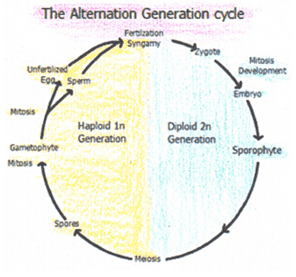
Asexual or vegetative reproduction is the reproductive process that does not involve meiosis or fertilization. The absence of fertilization means that reproduction can only occur in the sporophyte stage or the gametophyte stages. This means the organisms is a clone of itself producing a genetically identical organism.
Plants are the foundation of the Earth’s ecosystem. Plants are the producers in the ecosystem. Nature has set a balanced ratio of around 10 to 1 producers to consumers. When this ratio is breached the natural energy cycle deploys a plague in one direction and a famine in the other direction in an attempt to bring the balance back to equilibrium. This in itself means that producers will always hold the balance of 10 to 1 consumer. All living things are dependent either directly or indirectly on the energy emitted by the sun so that photosynthesis can take place and the by products of oxygen is in supply to all consumers and glucose is in supply for the first order consumers – herbivores to start the chain reaction. Plants also reduce soil erosion, and influence the natural water cycles and quality. Consumers are ranked as Primary consumers, those are herbivores, Secondary consumers those that eat herbivores and Tertiary consumers those that eat secondary consumers.
<<Botany an Overview Photo1.3>>
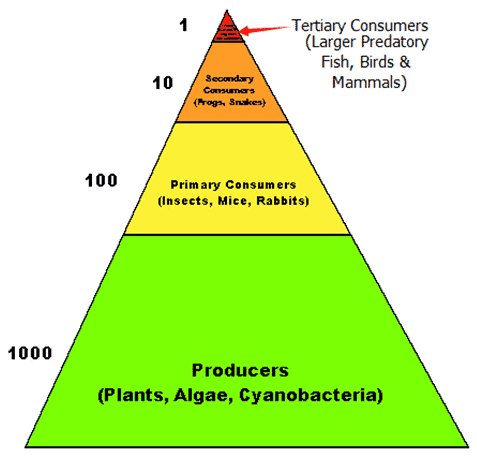
20 elements are required by plants:
The 3 major elements comprise the bulk of the plant C, H, O
6 macronutrients are required at 0.1 to 6mm of the dry weight of plants
N, P, K, S, Ca, Mg
11 micronutrients are required at 1 to 300 ppm of the dry weight of plants Fe, Zn, Cu, Mo, B, Mn, Cl, Ni
Refer to Composts and Elements.
All members of the Plant Kingdom have the following characteristics:
* They all have eukaryotic cells – A eukaryote cells are cells that contain a nucleus and other structures enclosed within membranes..
* They all are multicellular organisms.
* They all plants are autotrophic – That is they produce their own food through the process of photosynthesis.
* Their reproduction is mostly sexual however some members can reproduce both sexually and asexually while a few are reduced to just asexual reproduction.
The differences in plant size and structure result from the different structures of the various cells that make up the organs of the plant body. Three cell organelles are important for plant characteristic – the cell wall, chloroplasts and nucleus.
<<Botany an Overview Photo1.4>>
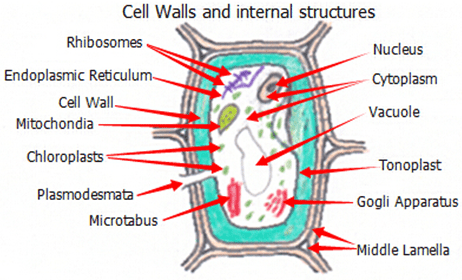
Middle lamella: The middle lamella is the first layer formed during cell division. It makes up the outer wall of the cell and is shared by adjacent cells.
Primary wall: formed inside the middle lamella and consists of a rigid skeleton of cellulose microfibrils embedded in a gel-like matrix composed of pectic and cellulose compounds. This wall contains everything that is located between the plasma membrane and the cuticle.
Functions of the primary wall are:
* Structural to physically support the plant.
* Maintain and determine the shape of the individual cells.
* Ultimately leads to the form and shape of the mature plant.
* To maintain a consistent turgor pressure within the cell through osmosis.
* To control the rate and direction of growth.
* Carbohydrate storage especially within the seeds.
* Interactions and transportation of minerals and fluids between cells through osmosis.
Secondary wall is formed after the cell has stopped growing. The secondary wall is rigid and provides vertical strength. It is mainly made of cellulose and lignin.
Plasmodesmata are small passages that penetrate the layers of the cell wall. They provide pathways for transporting cytoplasmic molecules from one cell to another.
Cell Wall is composed of pectic acid: The polymer of over 100 galacturonic acid molecules which are very hydrophilic and soluble. They become much hydrated and because of salts and form salt bridges utilizing Ca+2 and Mg+2 that are insoluble gels.
Major components of middle lamella but also found in primary walls is
Pectin:
* polymer of 200+ galacturonic acid molecules
* many of the carboxyl groups are methylated (COOCH3)
* less hydrated then pectic acid but soluble in hot water
Cellulose are glucose polymers which typically consist of 1,000 to 10,000 beta D glucose residues and cellulose polymers associate through H-bonds. The H-bonding of many cellulose molecules to each other results in the formation of micro fibres and the micro fibres can interact to form fibres. Certain cells, like those in cotton ovules, can grow cellulose fibres of enormous lengths.
Structural proteins: One type of cell wall protein is called glycoproteins. These contain carbohydrate side chains on certain amino acids. One common group of cell wall proteins are characterized by having an abundance of the amino acid hydroxyproline.
Chloroplasts are sites that conduct photosynthesis within the cell. The photosynthetic green pigment chlorophyll captures the energy from the sun and stores it as Adenosine triphosphate (ATP) and Nicotinamide adenine dinucleotide phosphate (NADPH molecules) freeing oxygen from water in the process. All of the green structures in plants, including stems, buds and unripen fruit, contain chloroplasts. The majority of photosynthesis activity in most plants occurs in the leaves. On the average, the chloroplast density on the surface of a leaf is about one-half million per square millimetre.
Chloroplasts are one of several types of plastids which are important cell organelles. They are the site of manufacture and storage of important chemical compounds used by the cell and often contain various types of pigments used in various types of sugar manufacturing during photosynthesis. The types of pigments present can change or determine the cell’s colour.
The colourless leucoplasts primary function is in the synthesis of sugars into starch, oils, and proteins.
There are several types of chromoplasts which are involved in the manufacture of carotenoid pigments and the green coloured chloroplasts which contain the pigments “chlorophyll a” and “chlorophyll b,” which are able to absorb the light energy needed for photosynthesis to occur. They are the distinctive yellow, orange and red colours in plants leaves, fruits, roots and stems. They are associated with increases in the accumulation of carotenoid pigments and are responsible for the conversion of chloroplasts into chromoplasts. Other reactions include the synthesis of complex sugars, starches, lipids, aromatic compounds, vitamins and hormones.
The numbers of the various types of plastids are based upon the needs of the cell, which may be influenced by environmental conditions.
Chloroplast Structure:
The organelle is surrounded by a double membrane.
The area between the two layers that make up the membrane is called the intermembrane space. The outer layer of the double membrane is much more permeable than the inner layer and contains a number of embedded membrane transport proteins.
The stroma is a semi-fluid, inner membrane which comprises of a complex mix of enzymes and water. The enzymes dissolve in the stroma make up most of the chloroplast’s volume. Like mitochondria, chloroplasts possess their own genomes (DNA), therefore the stroma contains chloroplast DNA and special ribosomes and RNA.
Embedded in the stroma is a complex network of flattened discs stacked upon each other known as thylakoid. Each stack of thylakoids is collectively known as a granum.
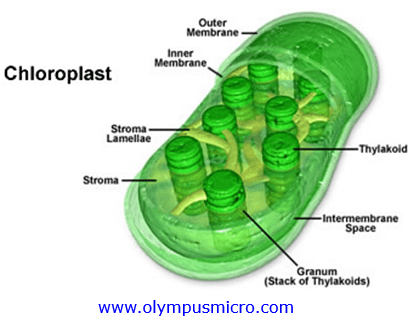
Plant cells are remarkable in that they have two organelles specialized for energy production: chloroplasts, which create energy through photosynthesis, and mitochondria which generate energy through respiration using ATP and NADPH.
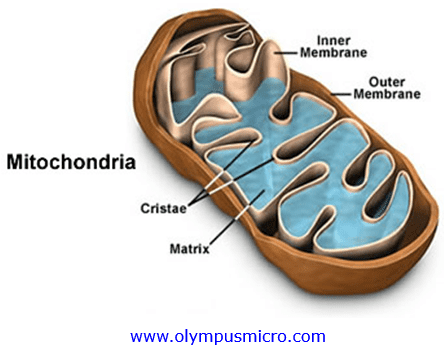
Both the mitochondria and the chloroplast have their own DNA and reproduce independently of the cell in which it is found; an apparent case of endosymbiosis. These lead scientists to hypothesize that early forms of small bacteria; free-living prokaryote bacteria were eaten, but are not dissolved, by larger prokaryote bacteria. These smaller organisms may have been able to resist the digestive enzymes of the engulfing organism similar to those bacteria which live in the guts of animals today.
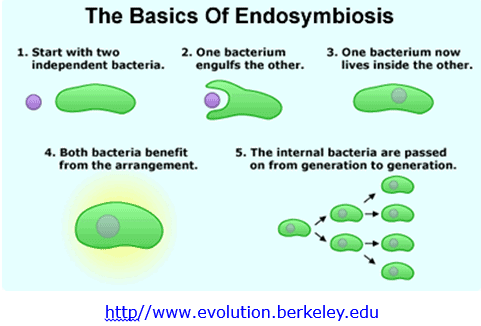
As suggested by this hypothesis, the two organisms developed a symbiotic relationship over time, the larger organism providing the smaller with nutrients and the smaller organism providing ATP molecules to the larger one. Eventually, the larger organism developed into the eukaryotic cell, the smaller organism into the chloroplast.
DNA evidence strongly indicates that the eukaryotic organisms that later became plants likely added the photosynthetic pathway in this way, by acquiring a photosynthetic bacteria as an endosymbiont. This is enhanced by the fact that the cells have an independent DNA history which developed from separate lines.
Chloroplasts continue to exhibit a number of prokaryotic traits. Their DNA is circular, as in prokaryotes, and their ribosomes and reproductive methods, binary fission, are more like those of the prokaryotes.
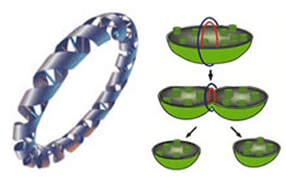
Remember:
1. The largest organisms on earth are the giant Sequoia trees while the smallest are some of the mosses.
2. Plants are thought to have evolved from Blue Green Algae.
3. The earliest fossil evidence of land plants dates to the Ordovician Period.
4. Xylem is plant tissue involved in structural support and water conduction.
5. Phloem is plant tissue which functions in food conduction.
6. All vascular plants have these three structures. Roots, stems and leaves.
7. Mosses are nonvascular plants in the Division Bryophyta.
8. Asexual reproduction in plants is often called vegetive reproduction.
9. All living things are dependent either directly or indirectly on the energy produced by the process of photosynthesis.
10. Carbon, Hydrogen and Oxygen are the three elements comprise the bulk of a plant.
11. The Middle Lamella is the part of the cell wall that cements plant cells together.
12. The inner portions of plant cells are connected with passages through the cell wall called plasmodesmata.
13. Cellulose is the major component of primary and secondary cell wall layers.
14. On average, the chloroplast density on the surface of a leaf is about 500,000 per square millimeter.
15. The complex mixture of enzymes and water inside a chloroplast is called stroma.
16. Chloroplasts create energy through photosynthesis and mitochondria generate energy through mitochondria.
17. Chloroplasts contain circular shaped DNA.
18. All plants have Eukaryotic cells.
19. Autotrophic is applied to organisms that can make their own food through the process of photosynthesis. Some plants are both parasitic and autrophic.
20. Cellulose is a sugar molecule which is composed of Beta D Glucose polymers.
Further Comments from Readers:
“Hi reader, it seems you use The Bible of Botany a lot. That’s great as we have great pleasure in bringing it to you! It’s a little awkward for us to ask, but our first aim is to purchase land approximately 1,600 hectares to link several parcels of N.P. into one at The Pinnacles NSW Australia, but we need your help. We’re not salespeople. We’re amateur botanists who have dedicated over 30 years to saving the environment in a practical way. We depend on donations to reach our goal. If you donate just $5, the price of your coffee this Sunday, We can help to keep the planet alive in a real way and continue to bring you regular updates and features on Australian plants all in one Botanical Bible. Any support is greatly appreciated. Thank you.”
In the spirit of reconciliation we acknowledge the Bundjalung, Gumbaynggirr and Yaegl and all aboriginal nations throughout Australia and their connections to land, sea and community. We pay our respect to their Elders past, present and future for the pleasures we have gained.